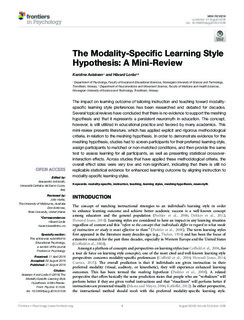| dc.contributor.author | Karoline, Aslaksen | |
| dc.contributor.author | Lorås, Håvard | |
| dc.date.accessioned | 2018-08-27T12:27:06Z | |
| dc.date.available | 2018-08-27T12:27:06Z | |
| dc.date.created | 2018-08-22T08:57:07Z | |
| dc.date.issued | 2018 | |
| dc.identifier.issn | 1664-1078 | |
| dc.identifier.uri | http://hdl.handle.net/11250/2559437 | |
| dc.description.abstract | The impact on learning outcome of tailoring instruction and teaching toward modality-specific learning style preferences has been researched and debated for decades. Several topical reviews have concluded that there is no evidence to support the meshing hypothesis and that it represents a persistent neuromyth in education. The concept, however, is still utilized in educational practice and favored by many academics. This mini-review presents literature, which has applied explicit and rigorous methodological criteria, in relation to the meshing hypothesis. In order to demonstrate evidence for the meshing hypothesis, studies had to screen participants for their preferred learning style, assign participants to matched or non-matched conditions, and then provide the same test to assess learning for all participants, as well as presenting statistical crossover-interaction effects. Across studies that have applied these methodological criteria, the overall effect sizes were very low and non-significant, indicating that there is still no replicable statistical evidence for enhanced learning outcome by aligning instruction to modality-specific learning styles. | nb_NO |
| dc.language.iso | eng | nb_NO |
| dc.publisher | Frontiers Media | nb_NO |
| dc.rights | Navngivelse 4.0 Internasjonal | * |
| dc.rights.uri | http://creativecommons.org/licenses/by/4.0/deed.no | * |
| dc.title | The Modality-Specific Learning Style Hypothesis: A Mini-Review | nb_NO |
| dc.type | Journal article | nb_NO |
| dc.type | Peer reviewed | nb_NO |
| dc.description.version | publishedVersion | nb_NO |
| dc.source.volume | 9 | nb_NO |
| dc.source.journal | Frontiers in Psychology | nb_NO |
| dc.identifier.doi | https://doi.org/10.3389/fpsyg.2018.01538 | |
| dc.identifier.cristin | 1603662 | |
| dc.description.localcode | Copyright © 2018 Aslaksen and Lorås. This is an open-access article distributed under the terms of the Creative Commons Attribution License (CC BY) | nb_NO |
| cristin.unitcode | 194,65,30,0 | |
| cristin.unitname | Institutt for nevromedisin og bevegelsesvitenskap | |
| cristin.ispublished | true | |
| cristin.fulltext | original | |
| cristin.qualitycode | 2 | |

